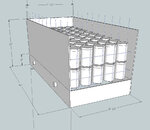OgopogoSalsa
Newbie level 3
Greetings all !
I am new to this community but I hope to find some knowledge in regards to a project I working on.
I am building a custom bit of gear for a small canned Salsa company I am starting up in Canada! The trick to my little business is in the custom canning trough I am building. Essentially it is a bath of boiling water, large enough to submerge 100 mason canning jars.
The water is to be boiled via x4 4500watt 240v elements. These are off-the-shelf hot-water tank elements from Home Depot and should pump in more than enough energy to boil my water... at least as far as my calculations go.
MY QUESTION is this: In what ways could I control the power supplied to the heating elements?
I am currently trying to find variable controls like that found on electric stove ranges but I haven't been able to find schematics for the internal workings of any variable controls...
my requirement is that I am able to maintain boiling water without running the heating elements at 100% all day. Any help is greatly appreciated!
Smile On
-Tyler

I am new to this community but I hope to find some knowledge in regards to a project I working on.
I am building a custom bit of gear for a small canned Salsa company I am starting up in Canada! The trick to my little business is in the custom canning trough I am building. Essentially it is a bath of boiling water, large enough to submerge 100 mason canning jars.
The water is to be boiled via x4 4500watt 240v elements. These are off-the-shelf hot-water tank elements from Home Depot and should pump in more than enough energy to boil my water... at least as far as my calculations go.
MY QUESTION is this: In what ways could I control the power supplied to the heating elements?
I am currently trying to find variable controls like that found on electric stove ranges but I haven't been able to find schematics for the internal workings of any variable controls...
my requirement is that I am able to maintain boiling water without running the heating elements at 100% all day. Any help is greatly appreciated!
Smile On
-Tyler
